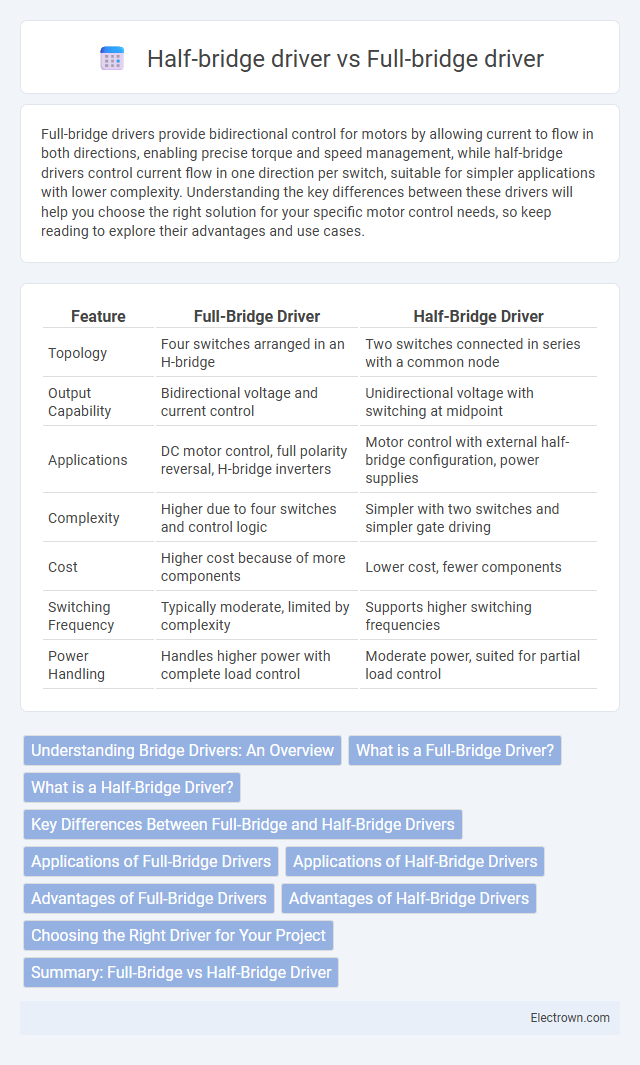Full-bridge drivers provide bidirectional control for motors by allowing current to flow in both directions, enabling precise torque and speed management, while half-bridge drivers control current flow in one direction per switch, suitable for simpler applications with lower complexity. Understanding the key differences between these drivers will help you choose the right solution for your specific motor control needs, so keep reading to explore their advantages and use cases.
Table of Comparison
| Feature | Full-Bridge Driver | Half-Bridge Driver |
|---|---|---|
| Topology | Four switches arranged in an H-bridge | Two switches connected in series with a common node |
| Output Capability | Bidirectional voltage and current control | Unidirectional voltage with switching at midpoint |
| Applications | DC motor control, full polarity reversal, H-bridge inverters | Motor control with external half-bridge configuration, power supplies |
| Complexity | Higher due to four switches and control logic | Simpler with two switches and simpler gate driving |
| Cost | Higher cost because of more components | Lower cost, fewer components |
| Switching Frequency | Typically moderate, limited by complexity | Supports higher switching frequencies |
| Power Handling | Handles higher power with complete load control | Moderate power, suited for partial load control |
Understanding Bridge Drivers: An Overview
Full-bridge drivers enable control of current flow in both directions through a load, allowing for bidirectional motor control and efficient power management in DC motor applications. Half-bridge drivers, which consist of two switches, control power delivery in a single direction and are commonly used in simpler, cost-effective circuits requiring unidirectional current. Selecting between full-bridge and half-bridge drivers depends on the application's requirements for complexity, control precision, and operational flexibility.
What is a Full-Bridge Driver?
A full-bridge driver is an electronic circuit designed to control the direction and speed of a DC motor by using four switches arranged in an H-bridge configuration, allowing current to flow in both directions through the motor. It provides complete motor control by enabling forward, reverse, and braking operations, which is essential for applications requiring bidirectional motor movement. Compared to half-bridge drivers, full-bridge drivers offer increased versatility and precise control in motor driving systems.
What is a Half-Bridge Driver?
A Half-Bridge Driver controls two switches, typically MOSFETs or IGBTs, connected in series to deliver power to a load with a common midpoint. It provides efficient switching for DC-DC converters, motor drivers, and Class-D amplifiers by enabling precise control of voltage polarity and current flow. Compared to a Full-Bridge Driver, a Half-Bridge Driver uses fewer components and simpler control, making it ideal for lower power applications and simpler circuit designs.
Key Differences Between Full-Bridge and Half-Bridge Drivers
Full-bridge drivers control four switches to enable bidirectional current flow, making them ideal for driving motors with precise control and full power delivery. Half-bridge drivers use two switches and are suited for simpler applications with unidirectional current flow or lower power requirements. Your choice depends on the control complexity, voltage range, and power demands of your specific electronic circuit or motor application.
Applications of Full-Bridge Drivers
Full-bridge drivers are ideal for applications requiring bidirectional control of DC motors, such as robotics, electric vehicles, and industrial automation systems, where precise motor speed and direction control is essential. These drivers offer higher torque and enhanced efficiency in power conversion compared to half-bridge drivers, making them suitable for driving inductive loads. Your choice of a full-bridge driver enables seamless implementation of H-bridge topologies, which support regenerative braking and energy recovery in advanced motor control systems.
Applications of Half-Bridge Drivers
Half-bridge drivers are commonly used in applications such as motor control, power conversion, and Class D audio amplifiers due to their efficiency and ability to handle moderate voltage levels. They provide effective switching for single-phase inverters and DC-DC converters, making them ideal for battery-powered devices and renewable energy systems. Your choice of half-bridge drivers can optimize performance in compact power electronics with cost and complexity advantages over full-bridge drivers.
Advantages of Full-Bridge Drivers
Full-bridge drivers provide precise control of motor direction and torque by enabling current flow in both directions through the load, making them ideal for bidirectional motor control applications. Their ability to deliver higher power density and increased efficiency results from using all four transistor switches, which reduces power losses compared to half-bridge configurations. Full-bridge drivers also offer improved thermal management and enhanced fault tolerance due to balanced current distribution and symmetrical circuit design.
Advantages of Half-Bridge Drivers
Half-bridge drivers offer compact design benefits and reduced component count compared to full-bridge drivers, resulting in lower system cost and simplified circuit layout. They provide efficient power management by controlling two switches in series, enabling effective switching with fewer gate drivers. This makes half-bridge drivers ideal for applications requiring medium power control and modular scalability.
Choosing the Right Driver for Your Project
Selecting the right driver for your project depends on power requirements and application complexity; full-bridge drivers offer efficient bidirectional control and higher power handling, ideal for motor control and H-bridge circuits. Half-bridge drivers are suitable for simpler applications with lower voltage and current demands, providing cost-effective solutions for driving single devices or phases. Assessing load type, voltage levels, and switching speed ensures optimal performance and energy efficiency.
Summary: Full-Bridge vs Half-Bridge Driver
Full-bridge drivers deliver four switching devices enabling bidirectional current flow, ideal for controlling motors with precise speed and direction. Half-bridge drivers contain two switches and are typically used in simpler or single-ended power conversion applications with less control complexity. Your choice depends on the application's power requirements and control sophistication, with full-bridge drivers favored for full motor control and half-bridge drivers suited for lower power or simpler designs.
Full-bridge driver vs Half-bridge driver Infographic

 electrown.com
electrown.com